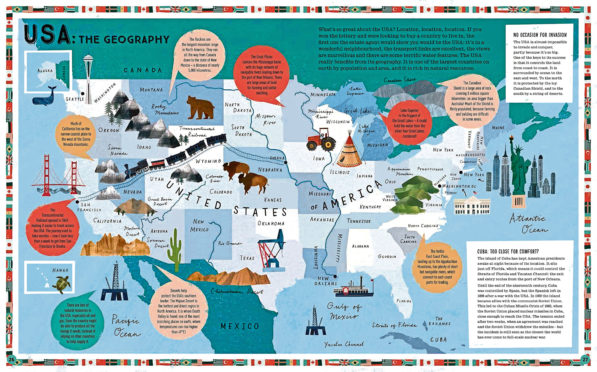
As diplomatic editor for Sky News, Tim Marshall survived being bombed and shot at. But his knowledge informed his best-seller Prisoners of Geography.
Now, he tells Sally McDonald how his new child-friendly version shows how geography shaped the history of our world.
What made you want to publish an illustrated abridged edition – Prisoners of Geography: Our World Explained in 12 Simple Maps?
I had an amazingly positive response to the original from young people taking their secondary school exams.
The highest praise regularly comes from undergraduates saying they’d read it at school and it inspired them to study geography and/or international relations at university.
So it felt like a natural progression and I’m hoping it will help inspire younger minds. But it’s also great for those adults who want simple answers to the bigger questions – like how did America become a super power, why do people go to war and why are some countries rich while others are so poor?
How long did your research take and to where, geographically, did it take you?
In some ways, the research took 30 years insofar as the book draws on my career as a foreign correspondent, but the actual writing and fact checking took a year.
The main countries that have influenced my thinking, through my own experiences there, are probably Bosnia, Serbia, the USA, Russia, Israel/Palestine and Japan. I’ve been to almost 70 countries and geography has played an important role in the history and development of every single one of them, so I tried to cover as much of the world as is possible in a limited number of pages.
What challenges have you had in the making of this book and in your work in general?
I’ve witnessed some very difficult things during my time in war zones. But some of these experiences have helped me to understand how certain wartime actions are influenced by geographical limitations.
For example, 25 years ago I was standing on a Bosnian hillside watching a village on fire in the valley below. I asked an officer why it was being burned down. It just seemed like needless destruction to me.
He pointed to the end of the valley and said: “We need clear access to the road there.”
That got me thinking about decisions based on the landscape and I carried the lesson with me from then on. The main challenge for this book was presenting the information in a way that would be easy to grasp for a younger audience.
Who will get the most out of this edition?
It’s for everyone. It’s a simplified version of the original book which, combined with the incredible illustrations would appeal to children and young adults around the age of 8 to 14. But I think adults will definitely appreciate it as well – anyone who wants a quick primer in geopolitics but might not reach for an academic tome will definitely find some of the key ideas in its pages.
What sets it aside from other history books?
The difference between this book and a basic map or history book is the understanding it offers on how those facts relate to global politics. For example, Western Russia is flat and that means it is hard to defend from invasion.
What books have inspired you throughout your life?
I grew up a voracious reader, and would get through several books a week. It was mostly fiction back then. When I was younger, before the age of 10, I was bewitched by Paddington, The Lion, The Witch And The Wardrobe, and Rudyard Kipling’s Just So stories. Later on Animal Farm and Lord of the Flies caught my attention, as well as Tolkein and quite a lot of classic sci-fi such as The Day of the Triffids.
What are you working on next?
A book and I’m afraid I can’t tell you any more than that right now! But geography will again have an important part to play.
Prisoners of Geography: Our World Explained in 12 Simple Maps By Tim Marshall, illustrated by Grace Easton and Jessica Smith, is published by Simon & Schuster and Elliott & Thompson

Enjoy the convenience of having The Sunday Post delivered as a digital ePaper straight to your smartphone, tablet or computer.
Subscribe for only £5.49 a month and enjoy all the benefits of the printed paper as a digital replica.
Subscribe